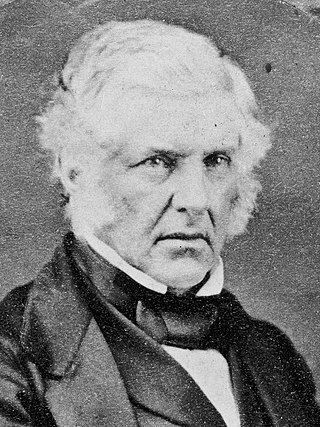Related Research Articles

Sir Francis Dillon Bell was a New Zealand politician of the late 19th century. He served as New Zealand's third Minister of Finance, and later as its third Speaker of the House. The town of Bell Block near New Plymouth – on land Bell bought from the Puketapu iwi in 1849 – is named after him, as is Bell Street, Whanganui. Bell's son, Francis Henry Dillon Bell, became the first New Zealand born Prime Minister in 1925.
The 2nd New Zealand Parliament was a term of the Parliament of New Zealand. It opened on 15 April 1856, following New Zealand's 1855 election. It was dissolved on 5 November 1860 in preparation for 1860–61 election. The 2nd Parliament was the first under which New Zealand had responsible government, meaning that unlike previously, the Cabinet was chosen by Parliament rather than by the Governor.
Charles Brown was a New Zealand politician from the Taranaki area.

Nelson is a New Zealand parliamentary electorate, returning one Member of Parliament to the House of Representatives of New Zealand. From 1853 to 1860, the electorate was called Town of Nelson. From 1860 to 1881, it was City of Nelson. The electorate is the only one that has continuously existed since the 1st Parliament in 1853.

New Plymouth is a New Zealand parliamentary electorate. It was first created for the 1st New Zealand Parliament in 1853 and has existed since, with one 32-year interruption. The electorate was initially called Town of New Plymouth.
Taranaki was a New Zealand parliamentary electorate that existed for three periods between 1881 and 1996. It was represented by nine Members of Parliament.
Hutt was a New Zealand parliamentary electorate. It was one of the original electorates in 1853 and existed during two periods until 1978. It was represented by 13 Members of Parliament.
The former New Zealand parliamentary electorate on the western inner city of Auckland, was known as City of Auckland West from 1861 to 1890, and then Auckland West from 1905 to 1946.
Omata was a New Zealand electorate. It was located in Taranaki and based on the township of Omata. One of the original 24 electorates, it existed from 1853 to 1870.
Wanganui and Rangitikei is a former parliamentary electorate that existed from 1853 to 1860. It was represented by two Members of Parliament.
Wairarapa and Hawke's Bay is a former parliamentary electorate in the Wellington region of New Zealand, from 1853 to 1859, when it was extended into previously unincorporated territories, split in two and replaced by County of Hawke with its southern portion being the newly created Wairarapa electorate. It is the first general electorate to have been abolished in New Zealand.
Wellington, was a parliamentary electorate in Wellington, New Zealand. It existed from 1853 to 1905 with a break in the 1880s. It was a multi-member electorate. The electorate was represented, over the years, by 24 members of parliament.
The third New Zealand Parliament was a term of the Parliament of New Zealand. Elections for this term were held between 12 December 1860 and 28 March 1861 in 43 electorates to elect 53 MPs. Two electorates were added to this during this term, Gold Fields District and a new Dunedin electorate created by splitting the existing City of Dunedin into Dunedin and Suburbs North and Dunedin and Suburbs South, increasing the number of MPs to 57. During the term of this Parliament, six Ministries were in power.

Thomas King was a 19th-century New Zealand politician. He served in the 1st and 2nd Parliaments, and was otherwise active in New Plymouth. He was one of the first settlers, coming out on the first ship to New Plymouth in 1841.

William Cutfield King was a 19th-century New Zealand politician who was elected to Parliament, but was killed in the New Zealand Wars before the first session.
The 4th New Zealand Parliament was a term of the Parliament of New Zealand.
The 7th New Zealand Parliament was a term of the Parliament of New Zealand.
The Grey and Bell by-election 1858 was a by-election held in the Grey and Bell electorate during the 2nd New Zealand Parliament, on 17 May 1858, and was, the second by-election in the electorate.

The 1865 Town of New Plymouth by-election was a by-election held in the Town of New Plymouth electorate during the 3rd New Zealand Parliament, on 19 May 1865. The by-election was caused by the resignation of the incumbent, Charles Brown, and was won unopposed by Henry Sewell. Whilst Sewell was not a local resident, he was a member of the government through his appointment to the Legislative Council, the upper house of Parliament. Sewell accepted the invitation to represent the electorate, as him becoming a member of the lower house was seen to strengthen the government.
References
- ↑ Wilson, James Oakley (1985) [First ed. published 1913]. New Zealand Parliamentary Record, 1840–1984 (4th ed.). Wellington: V.R. Ward, Govt. Printer. OCLC 154283103.
- ↑ Foster, Bernard John (22 April 2009). "Brown, Charles". An Encyclopaedia of New Zealand. Retrieved 13 June 2010.
- ↑ "HOUSE OF REPRESENTATIVES". Otago Witness . No. 340. 5 June 1858. p. 5. Retrieved 30 April 2010.
- ↑ WELLS, B. (1878). "CHAPTER XXVIII: THE TARANAKI PIONEERS". The history of Taranaki. pp. 302–304. Retrieved 17 June 2010.
- ↑ Cyclopedia Company Limited (1908). "Former Members Of The House Of Representatives". The Cyclopedia of New Zealand : Taranaki, Hawke’s Bay & Wellington Provincial Districts. Christchurch. Retrieved 16 June 2010.
- ↑ "The Elections". Taranaki Herald. Vol. XXVII, no. 3222. 9 September 1879. p. 2. Retrieved 26 June 2010.
- ↑ "Election for the Grey and Bell District". Taranaki Herald . Vol. VI, no. 303. 22 May 1858. p. 2. Retrieved 4 June 2013.
- ↑ "Election". Taranaki Herald . No. 220. 18 October 1856. p. 3. Retrieved 2 May 2013.